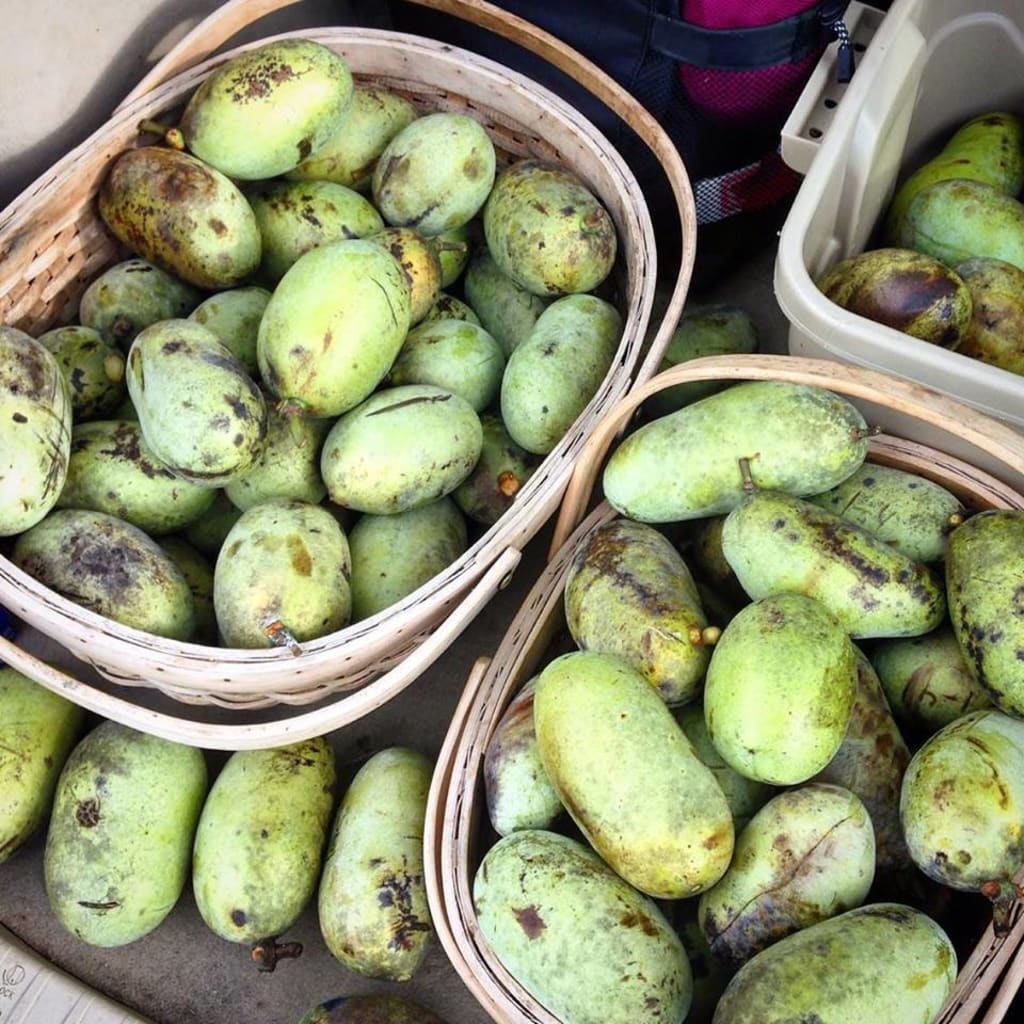In the PawPaw Patch
The past and future of Asimina triloba

I can't remember the first time I ever tasted a pawpaw. It was well over a decade ago. The flavor was enthralling - aromatic banana, mango, and other rich flavors I couldn't define at the time. Back in 2003 I had planted 4 trees on my parent's property, one of those trees still persists today. Almost 20 years and 5,000 Prius miles miles later, I have a micro-orchard of them in suburban Massachusetts.
In any case, I'm sitting here at 5AM watching the sunrise and waiting to go outside to visit my pawpaw trees. The species is Asimina triloba, and it is my muse. This is my spring and summer morning ritual - there's just something about these trees in particular, they're all character. Stately, mysterious, something about them screams "tropical!". The flowers are maroon, the color of congealed blood, pollinated by various species of carrion flies. They require two genetically distinct individuals to cross-pollinate, although there are degrees of self-compatibility observed in some. The fruit, an oblong to round puffy-looking greenish thing (see above), is borne late summer through autumn, and tastes like various combinations of banana-pineapple-mango-berry-caramel custard. The common name "fingersop" speaks to this odd fruit shape. Personally, I now have about 30 of these fantastic trees, collected from various parts of their range, as well as from breeders -- Kentucky, Iowa, Ohio, Indiana, to Italy and even Russia. This morning I'm checking on several newly grafted trees, watching for growth progress.
Grafting is an ancient method of cloning a tree with desired characteristics, by splicing part of it (aka. a "scion") onto a new, younger rootstock. By doing this you both duplicate and rejuvenate the older, desired tree or plant. Some cultivars, such as the 'Muscat of Alexandria' grape, have persisted for thousands of years via this method. To 'graft' a tree you need sharp, sterile tools, it's a surgical process involving dormant wood collected during winter, and active growing rootstock wood in the late spring/early summer. With pawpaws this is in late May or early June. I use garden shears and X-acto type blades cleaned with alcohol. You make matching incisions carefully, like puzzle pieces, and slide them together so the phloem and cambium touch. The cambium is the green part right under the bark, and the phloem is the water-transporting wood just beneath that. Then you wrap the graft tightly and wait for it to heal. If you do this right, you will see new growth within a few days, signaling cell-to-cell contact in the phloem, and the exchange of water and nutrients. Within a few weeks the wound should heal completely. It's always an exciting occasion when the new shoots begin to form.
Geographically, pawpaws occur form NJ to GA, over to Iowa, down to Louisiana and the Florida panhandle, occurring as far north as Ontario, Canada. They also to tend to inhabit areas once populated by indigenous Americans. In these areas, such as the Ohio river valley, one will find larger than average "wild" fruit. This begs a question, and an unknown secret past. It is recorded that the Cherokee used the bark of the trees to make netting and cordage, and logically they would not have destroyed the superior trees. It's also easy to imagine how the fruit was once transported by people over much of it's native range, trees with superior fruit would have been chosen. It was probably under the influence of human selection in parts of it's range. This type of domestication is considered passive, and likely went on for thousands of years. The history remains largely unknown, but, we can speculate based on it's large, delicious fruited tropical relatives - the soursop and cherimoya - that this fruit has undergone a similar proto-domestication process.
The trees are naturally somewhat finicky, they aren't the easiest species to deal with. When younger they require daily watering especially in summer heat. This is due to a massive underground root system which takes a few years to establish. The natural taproot can be many times longer than the tree you see above ground. Emerging from this basal root structure is a network of fine fleshy feeder roots which are crucial to the health of the tree. This matrix of delicate roots makes the tree nearly impossible to transplant once past a few years of age. As they age they may come to require nitrogen-heavy fertilizers and micronutrition if the soil isn't rich enough. I find soluble seaweed extracts especially beneficial. Pruning in winter is also essential to keep the trees a manageable height. When properly tended and fed their leaves are big and green and the tree is very tropical-looking.
As the species is now, the pawpaw remains mainly a dooryard tree, with growing commercial potential. The main drawbacks are the fruit's perishability; it has a very thin skin, prone to bruising, and does not ripen if picked too early. Once it drops naturally from the tree, the fruit over-ripens in a matter of a few days. Nonetheless efforts are being made to commercialize it, via u-pick orchards and low-temperature transport methods. The fruit remains in the initial stages of domestication, and will benefit from further effort to "tame" it, so to speak.
In the years to come, it is my personal intention to breed a few shorter season cultivars specifically for the northeast, to contribute something to the gene pool of this wonderfully delicious species. This will involve starting a few thousand of them from select seed, then picking and evaluating a handful of the very best ones that ripen early. The main issue with pawpaws slightly outside their native range is not their cold-hardiness, as the trees have a very deep winter dormancy, but rather their bloom-to-ripe fruit seasonal window. The species relies on summer heat both to grow/ripen it's fruit as well as to ripen it's new wood for the proceeding winter's dormancy. In the south, this window of seasonal heat may stretch from April to early November, before frosts set in. Here in the northeast, we have May to later in October to ripen fruit. This requires selecting for shorter season cultivars. The process itself takes about 12 years, 7 to grow seedlings to fruiting age, and 5 years for evaluating the consistency of the fruit, both inherently, and season to season. This will be my contribution to horticulture at large, and to the species; an homage to it's people and history as a passive domesticate.
About the Creator
Timothy James Lane
Sea Ghost






Comments
There are no comments for this story
Be the first to respond and start the conversation.